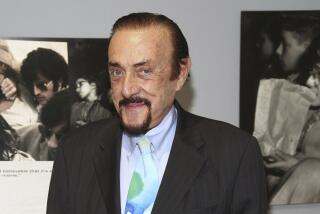Activist Documents Experiments on ‘Volunteer’ Inmates in Philadelphia
- Share via
PHILADELPHIA — The first time he walked into the prison in 1971, he noticed the telltale signs: gauze bandages on the arms, backs, even faces of inmate after inmate.
Had they rioted, he asked a guard. Were there fights? Stabbings?
No, was told. The prisoners were testing perfumes for the University of Pennsylvania.
“My jaw must have dropped six feet from my head to my feet,” Allen M. Hornblum says.
He would later discover that the inmates were not just test subjects for perfume, soap and cosmetics but for more menacing chemicals, from dioxin and psychological warfare agents to radioactive isotopes.
Now a 50-year-old prison activist and an instructor at Temple University, Hornblum never forgot that first visit to the Philadelphia prison system.
Five years ago, he began digging into what happened. The result is a new book, “Acres of Skin.”
In the decades after World War II, medical experiments on prisoners were largely unquestioned. By 1969, fully 85% of new drugs were tested on inmates in 42 prisons.
But could prisoners volunteer freely?
No, concluded the National Commission for the Protection of Subjects of Biomedical and Behavioral Research, which took a stand against the practice in the late 1970s.
“Prisoners are, as a consequence of being prisoners, more subject to coerced choice and more readily available for the imposition of burdens which others will not willingly bear,” the commission decided.
The U.S. Food and Drug Administration followed suit, and by the early 1980s, most prison testing was history.
In documenting the 20-year testing program at Holmesburg Prison, Hornblum used the Freedom of Information Act to unseal old records. He found physicians who ran experiments and inmates who had been test subjects.
He met Al Zabala, a thief who took part in the Army’s chemical testing at Holmesburg.
After a disorienting few hours in a padded cell, Zabala faced a barrage of questions from psychologists who returned him to his cell wearing a tag: “Please excuse this inmate’s behavior. He can’t think or act in a coherent manner.”
He left prison with $1,500--and some questions.
Had the testing caused him, a few years after his release, to lock himself in the bedroom of his sister’s house and refuse to eat for three days? Had it caused him to pass out at a bar one day?
Zabala doesn’t know. Neither do most of the other subjects, who apparently were never checked for long-term effects, Hornblum says.
“You had some extremely destitute people in there. They were poor, uneducated, confined. They were taking tests when they had no idea what they were involved with,” he says.
“The guards thought the inmates were absolutely crazy. Uniformly, their responses were they didn’t want to do it, but it’s the only way to make money.”
The money was good: a few hundred dollars a month to accept a number of tests, and more money for the Army’s chemical warfare tests.
Compared to stamping license plates, which paid pennies an hour, the tests were lucrative, and nearly everybody wanted in. Inmates even sued after the FDA drafted rules banning the tests.
Hornblum is most critical of Dr. Albert M. Kligman, then a Penn dermatology professor who ran the program for two decades. Kligman is known as the inventor of Retin-A, the acne and wrinkle remover that was first tested on a group of Holmesburg prisoners.
He went further than other scientists would go, Hornblum wrote, and sometimes ran several tests at the same time on the same prisoners, which is considered poor science.
“Kligman established something thoroughly unique in this country: a human research factory, a department store of experimental research,” Hornblum says.
Kligman refused to comment in detail about the book or his actions, saying only, “That’s 30 years ago and I have a very different accounting of it.”
Three tests particularly galled Hornblum.
* The Army tested an incapacitating agent, EA 3167, which it hoped to add to its chemical warfare stock. Inmates suffered hallucinations and confusion for up to three weeks. The prisoners’ nickname for EA 3167 and the other mind-altering drugs they received was “LSD.”
* Kligman tested radioactive isotopes despite having little training in radioactive medicine. To get a required license from the U.S. Atomic Energy Commission, he lied, Hornblum says. First, he named Dr. Benjamin Calesnick as the radiation protection officer, a title Calesnick denies having had. Later, Kligman fudged his credentials to get AEC approval as protection officer, the book says.
* In testing dioxin, a component of Agent Orange, for Dow Chemical Corp., Kligman went beyond company instructions, Hornblum says. He subjected several inmates to 7,500 micrograms of the toxic chemical--468 times as much as Dow wanted, according to the book. Two inmates sued, settling for a few thousand dollars.
A Penn spokesman says the tests were done before medical ethicists understood the vulnerability of prisoners.
“At the time that Dr. Kligman carried out these studies, the use of prisoners was widespread. So he was not using a population that, at the time, the standard practitioners in the field would have viewed as different,” says Dr. Richard Tannen, senior vice dean of Penn’s School of Medicine.
“I think now we know better,” Tannen says. “We do view prisoners--even if they have given adequate informed consent and have been paid--as a vulnerable population.”
More to Read
Sign up for Essential California
The most important California stories and recommendations in your inbox every morning.
You may occasionally receive promotional content from the Los Angeles Times.










